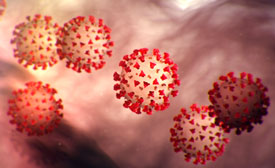Infection Control; Hepatitis and HIV; SARS; Flu
Click Here to Start
This will take you directly to the course content. Register or login when you reach the last chapter.
Infection Control Bundle—Course Summary

Source: CDC, 2020.
The very nature of healthcare settings makes them vulnerable to the spread of infections because they serve patients who are ill and are therefore susceptible hosts. Infection control and prevention and breaking the chain of infection are critical, especially during a pandemic. In view of the COVID-19 coronavirus pandemic, we offer this 15 contact hour course bundle at a special price of $29.
The course begins with an in-depth discussion of infection control/infection prevention policies required by the Centers for Disease Control and Prevention, including breaking the chain of infection, a primary component of safe, effective patient care.
The next section offers a thorough explanation of bloodborne pathogens, engineering and workplace practice controls, and the purpose of personal protective equipment (PPE). We continue with an overview of SARS-CoV-1, the coronavirus pathogen that in 2004 spread to 2 dozen countries, killing more than 800 people before it was contained. COVID-19 is a more infectious type of coronavirus, officially named SARS-CoV-2.
We conclude with Flu: The Other Deadly Virus, which describes the difference between seasonal and pandemic flu. The course includes a review of what happened and what was learned from the 1918–1919 flu pandemic. We also describe how viruses are named, how they spread, and the importance of vaccination and other public health measures.
Criteria for Successful Completion
Study the course material, achieve a score of 80% or higher on the post test (the post test can be repeated if a learner scores less than 80%), complete the course evaluation, and pay where required. No partial credit will be awarded.
Instructional Level
Introductory
Conflict of Interest / Commercial Support Disclosure
The planners and authors of this learning activity have declared no conflicts of interest, vested interest, or financial relationship that may influence the content of this activity. All information is provided fairly and without bias.
ATrain Education, Inc. received no outside financial or commercial support in the preparation, presentation, or implementation of this learning activity and has no affiliation with any company whose products or services are mentioned in this activity.
Target Audience
Nurses, nurse practitioners, advanced practice nurses, physical therapists, physical therapy assistants, occupational therapists and occupational therapy assistants*.
*If you are an OT or OTA, you may need the following information for relicensure:
![]() ATrain Education is an AOTA Approved Provider of professional development. Approved provider #6558. This distance learning-independent is offered at 1.5 CEUs, introductory, Foundational Knowledge. The assignment of AOTA CEUs does not imply endorsement of specific course content, products, or clinical procedures by AOTA.
ATrain Education is an AOTA Approved Provider of professional development. Approved provider #6558. This distance learning-independent is offered at 1.5 CEUs, introductory, Foundational Knowledge. The assignment of AOTA CEUs does not imply endorsement of specific course content, products, or clinical procedures by AOTA.
Learning Objectives
When you finish this course you will be able to*:
- List the 6 components of the chain of infection.
- Define bloodborne pathogens.
- Name 4 clinical symptoms associated with SARS-CoV-1, the organism that caused the 2004 SARS epidemic.
- Describe 3 differences between a seasonal and pandemic flu outbreak.
*Please note: attainment of course objectives will be assessed in the course evaluation.
JoAnn O'Toole, RN, BSN; Nancy Evans, BS; Susan Walters Schmid, PhD;
Marian McDonald, RN, MSN; Tracey Long, RN, PhD, APRN; Lauren Robertson, BA, MPT
![]() ATrain Education is an AOTA Approved Provider of professional development. Approved provider #6558. This distance learning-independent is offered at 1.5 CEUs, introductory, Foundational Knowledge. The assignment of AOTA CEUs does not imply endorsement of specific course content, products, or clinical procedures by AOTA.
ATrain Education is an AOTA Approved Provider of professional development. Approved provider #6558. This distance learning-independent is offered at 1.5 CEUs, introductory, Foundational Knowledge. The assignment of AOTA CEUs does not imply endorsement of specific course content, products, or clinical procedures by AOTA.
Available Credit
- 15.00 Contact hours

 Facebook
Facebook X
X LinkedIn
LinkedIn Forward
Forward